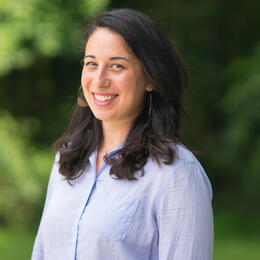Growing up in semi-rural western Massachusetts, Goldman recounts the impact forests had on her childhood: “I definitely took forests for granted. I was surrounded by them all the time and loved spending time in the woods.”
It was not until she received her bachelor's in environmental studies and moved to New York City that Goldman realized just how powerful that influence was. “Suddenly the type of forest I’d grown up in wasn’t as accessible to me anymore. I started learning about urban forestry, but pretty quickly realized that I wanted to go back to school to study forests more broadly.”
Looking back, Goldman realizes that she went into the master’s program not fully understanding the scope of forestry. It took completing her masters to appreciate all the nuances that went into forestry, and the puzzle pieces began to fall in place: “I discovered that I wanted to be able to take my knowledge of forest ecology and management and use that as a base from which to connect with other people who care about forests – whether they’re landowners, land managers, or just forest enthusiasts,” said Goldman. “Engaging with science and land management is one way to help people deepen their own relationships with the landscape.”
Upon completing her master’s degree, Goldman spent a few years working in forest landowner outreach. She managed the Quiet Corner Initiative, the landowner outreach and community engagement program of the Yale Forests, working primarily in northeastern Connecticut. Her experiences working with landowners was one of the reasons she joined Audubon.
“I was drawn to this work with Audubon because birds are a great way to get forestry conversations started. So many people care deeply about birds, so creating better habitat for forest birds is a wonderful way to introduce forest management concepts,” she explains. In the northeast, the bird habitat includes a lot of middle-aged trees. This is the result of colonial land use, deforestation, and abandoning agricultural fields. “Many of the things we recommend to diversify the age and structure of the forest for bird habitat also have the benefit of making the forest healthier overall and increasing its resilience to climate change.”
One of the key components of the forest program is to conduct site assessments. These are assessments recording the forest landscape scale, tree species, and different ages present. Goldman explains, “a site assessment is looking not just at the property, but also the area around it. It is important to consider the property within the greater landscape.”
“For the everyday person, I would also encourage them to practice thinking about forests as dynamic systems. Maybe there’s a trail you walk every day, and you feel very attached to and comforted by it, and you are used to it looking a certain way. But over time, you might notice changes – a tree falls here or there, saplings grow taller, you notice different animals. Changes in a forest can be as small as that or as large as a major windstorm, but either way they are an integral part of the forest. Sustainable forest management fits into the trajectory of a forest in the same way, emulating natural disturbance and often addressing challenges that arose from past land use.”
Forestry is historically a male dominated field, but Goldman notes this is changing. More women are being engaged in forestry and collaborating with other women. An example of this is Women Owning Woodlands, a network for women landowners. Goldman states, “women landowners being engaged is powerful.”
Currently, Goldman is helping finish a grant project with the Last Green Valley (an organization in northeastern Connecticut). This project includes providing bird habitat assessments and site visits to create bird management plans. One of Goldman’s upcoming projects will be expanding the Bird-Friendly Maple program to Connecticut. Information about New York’s Bird-Friendly Maple program can be found here.
“To me, forestry is one way of having an active relationship with the land. You will often hear forest management described as ‘an art and a science.’ Yes, it is science-based, but it’s also heavily place-based,” notes Goldman. “In order to practice forestry, you have to adapt your practices to suit the history and context of wherever you are working. Forest management can look like a lot of different things – from harvesting trees, to managing invasive species, to putting up deer fencing.”




